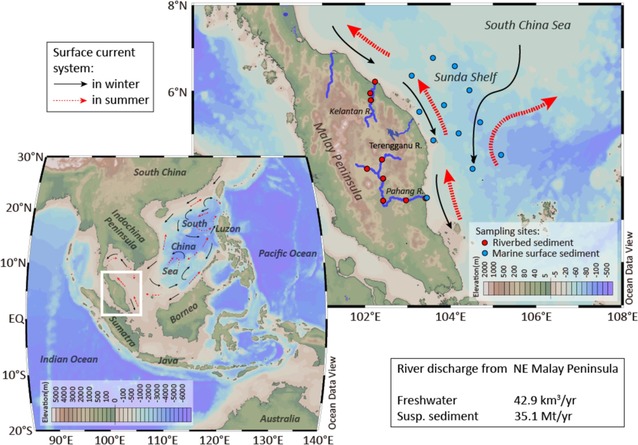Bingbing Wei a b, Stephanie Kusch c, Junjie Wu d, Hasrizal Shaari e, Gesine Mollenhauer b f g, Guodong Jia a *
aState Key Laboratory of Marine Geology, Tongji University, Shanghai, China
bAlfred Wegener Institute, Helmholtz Centre for Polar and Marine Research, Bremerhaven, Germany1
cISMER Institute of Marine Sciences, University of Quebec Rimouski, Rimouski, Canada
dDepartment of Environmental Science, Stockholm University, Stockholm, Sweden
eFaculty of Science and Marine Environment, University Malaysia Terengganu, Terengganu, Malaysia
fDepartment of Geosciences, University of Bremen, Bremen, Germany
gMARUM, Center for Marine Environmental Sciences, University of Bremen, Bremen, Germany
*Corresponding author.
E-mail address: jiagd@tongji.edu.cn (G. Jia).
Abstract
Tropical small mountainous rivers (SMRs), characterized by extensive basin weathering, discharge high amounts of sediments and particulate terrestrial organic carbon (OCterr) into the ocean. Burial of OCterr in marine sediments is important for atmospheric CO2 sequestration, yet its rate and efficiency remain not fully understood. Previous studies indicated generally low burial rates and burial efficiencies of OCterr in tropical coastal ocean settings influenced by SMRs but lacked detailed insights into specific processes and quantitative estimates of burial efficiencies. This study investigated δ13C values of bulk OC (δ13COC) and OCterr biomarker proxies (BIT, #ringstetra, ΣIIIa/ΣIIa and %C32 1,15-diol indices) in river surface sediments on the Malay Peninsula and marine surface sediments on the adjacent Sunda Shelf to quantify sedimentary OCterr contents, burial rates, and burial efficiencies along the river-estuary-ocean continuum. The substantial variation in δ13COC and OCterr biomarker proxies between riverbed and shelf sediments revealed a strong decrease in fractional OCterr contribution offshore and alongshore. Using a two-endmember mixing model based on δ13COC, we determined average OCterr contents of 1.40, 0.80, and 0.05 wt% in riverbed, river-mouth, and shelf sediments, respectively. The low OCterr contents in offshore sediments are attributed to physical mechanisms (such as local hydrodynamic regime and clay mineral flocculation) that affect sediment dispersal. This process leads to notably high burial rates of terrigenous sediment (11.5 ± 2.1 kg m− 2 yr− 1) and OCterr (99.2 ± 29.0 g m− 2 yr− 1) at river mouths. In com parison, burial rates of OCterr were significantly lower (0.1–0.5 g m− 2 yr− 1) offshore due to strong degradation of OCterr, resulting in a lower overall OCterr burial efficiency across the study area (18.2 %) compared to the global marginal sea average (21 %). These findings highlight the significance of carbon burial at the mouths of SMRs as CO2 sinks, whereas degradation of OCterr during offshore transport is a potentially large CO2 source in the tropical coastal ocean.
Full article:https://doi.org/10.1016/j.gca.2024.10.037

Fig. A map showing sampling sites on the Malay Peninsula and the adjacent Sunda Shelf.

